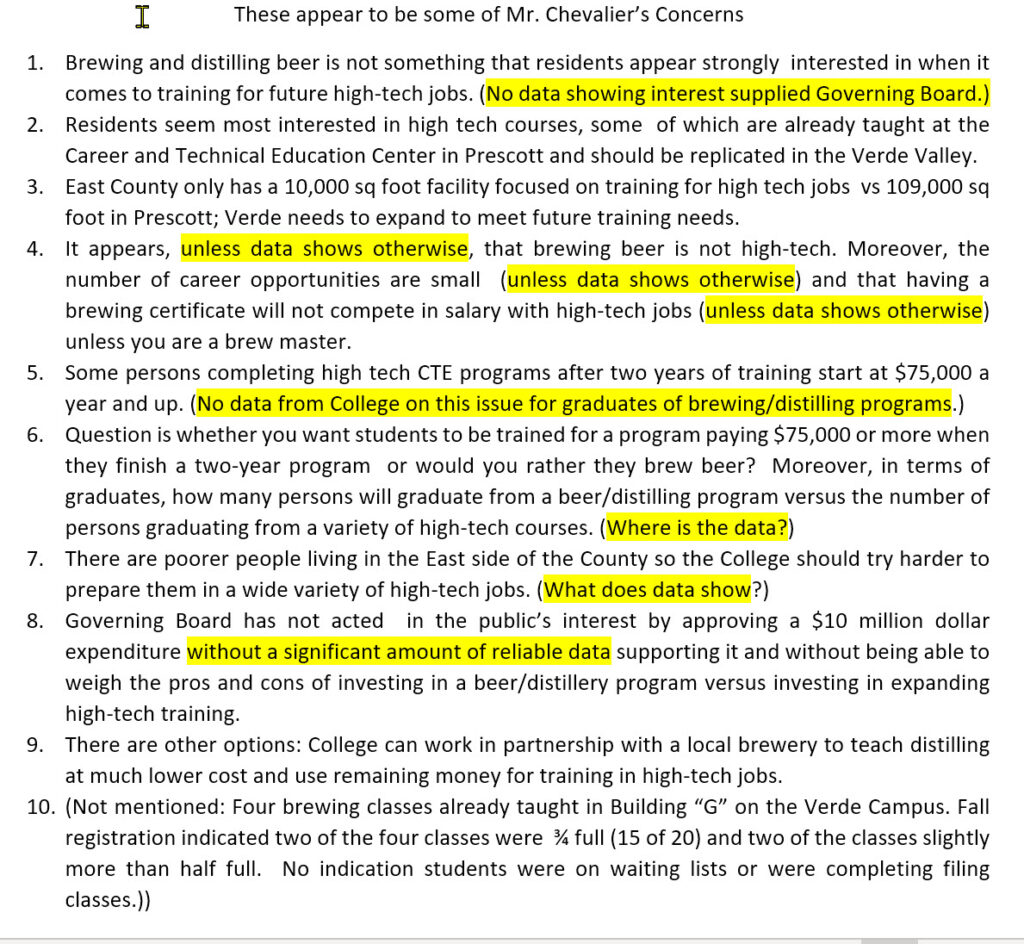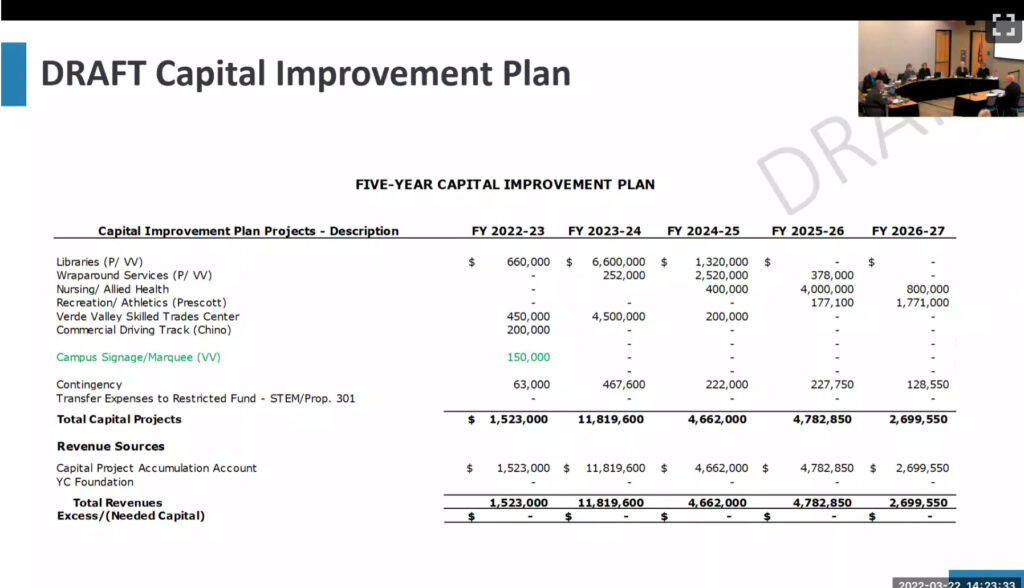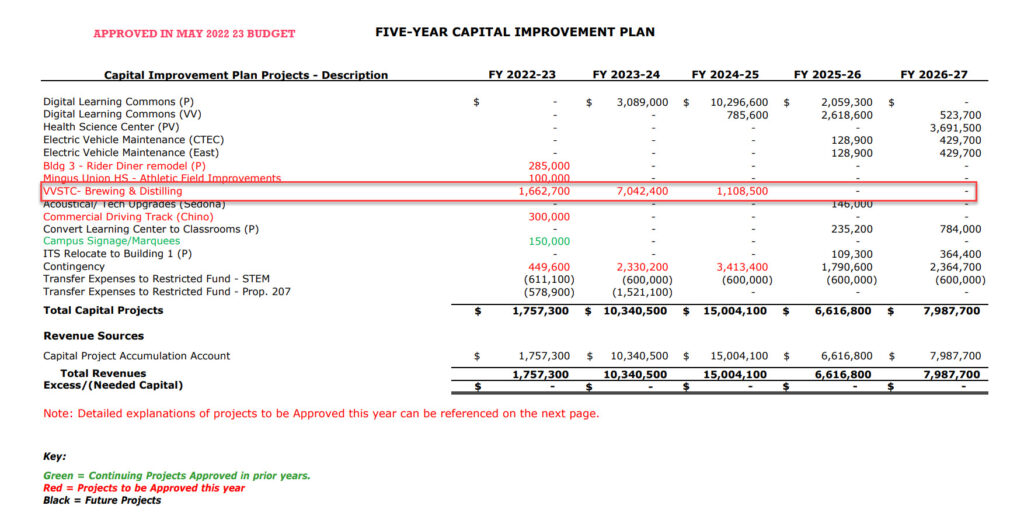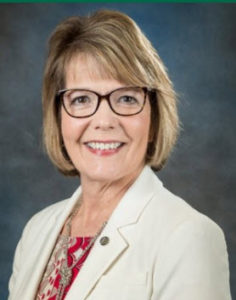Believes expenditure should focus on expanding facilities to train students in high-paying CTE jobs fearing Brewery/distilling courses will provide only a tiny number of such opportunities; says College provided Board insufficient data showing need for Brewery training when presenting budget; subsequent informal requests for data after Board meeting have not been answered
 Third District Representative to the Yavapai Community College District Governing Board, Paul Chevalier, has been an outspoken opponent of spending $10 million on developing a commercial brewing/distilling program to replace the existing program in the Verde Valley. (See fall registration below.)
Third District Representative to the Yavapai Community College District Governing Board, Paul Chevalier, has been an outspoken opponent of spending $10 million on developing a commercial brewing/distilling program to replace the existing program in the Verde Valley. (See fall registration below.)
During the May Governing Board meeting where the $10 million expenditure was approved 4-1, he argued the Community College should focus on using the money to develop a wide variety of high-tech training opportunities for Verde Valley students that may pay as much as $75,000 upon receiving a two-year certificate. He questioned whether a brewing program had the same potential. (Hear his arguments during the May Governing Board meeting by clicking here.)
Chevalier also raised the question of whether the College had conducted a sufficient needs assessment. One that would show that there is a significant need for a brewing/distilling program in the Verde Valley. There was no answer to this question at the May meeting.
Since the Governing Board meeting in May, Chevalier, who was interviewed by the Blog, says he has tried to obtain data from the Community College that would support using the money for a brewing program rather than a high-tech program. Specifically, data that would show a need for such training that would lead to high paying jobs for numbers of Verde Valley residents. However, his requests for data directed to the Community College have been rejected. The College administration’s refusal to provide such information has been supported by the Governing Board Chair.
In a last ditch attempt to obtain reliable data from the College, if it exists, Chevalier has turned to the Arizona Public Records law in an effort to obtain the information used by the College administration to make the $10 million recommendation to the Board. He is now awaiting a reply from the College to his Public Records request.

FALL 2022 ENROLLMENT IN VERDE CAMPUS BREWING PROGRAM

 Many unanswered questions surround the decision by Yavapai Community College to invest somewhere around $10 million to construct a 14,000 square foot commercial lab to teach brewing and distilling. The facility, when completed, will sell its product to the public. (
Many unanswered questions surround the decision by Yavapai Community College to invest somewhere around $10 million to construct a 14,000 square foot commercial lab to teach brewing and distilling. The facility, when completed, will sell its product to the public. (


 Vrindavan Silva of Cornville and Heidi Howden of Prescott were selected as 2022 Coca-Cola Leaders of Promise scholars. The two Yavapai Community College Phi Theta Kappa members and Honors students were among a total of 207 Leaders of Promise selected from 1,300 applicants nationwide. Selection for these awards was based on academic achievement and demonstrated leadership potential.
Vrindavan Silva of Cornville and Heidi Howden of Prescott were selected as 2022 Coca-Cola Leaders of Promise scholars. The two Yavapai Community College Phi Theta Kappa members and Honors students were among a total of 207 Leaders of Promise selected from 1,300 applicants nationwide. Selection for these awards was based on academic achievement and demonstrated leadership potential. The Association of Community College Trustees (ACCT) announced the recipients of its annual Regional Awards for community college trustees, equity programs, chief executive officers, faculty members, and professional board staff members on August 15. In the Pacific Region, Community College Board member Ray Sigafoos, English Professor and Faculty Senate President Dr. Karen Palmer, and Yvonne Martinez-Sandoval, the executive assistant to President Rhine and the District Governing Board, were recognized. They were among more than two dozen recipients of various awards from five regions made by ACCT this year.
The Association of Community College Trustees (ACCT) announced the recipients of its annual Regional Awards for community college trustees, equity programs, chief executive officers, faculty members, and professional board staff members on August 15. In the Pacific Region, Community College Board member Ray Sigafoos, English Professor and Faculty Senate President Dr. Karen Palmer, and Yvonne Martinez-Sandoval, the executive assistant to President Rhine and the District Governing Board, were recognized. They were among more than two dozen recipients of various awards from five regions made by ACCT this year.
 The Blog interviewed Cottonwood-Oak Creek School District Superintendent Steve King earlier this week. He had earlier contacted the Blog editor about high school dropout rates in Sedona and the Verde Valley.
The Blog interviewed Cottonwood-Oak Creek School District Superintendent Steve King earlier this week. He had earlier contacted the Blog editor about high school dropout rates in Sedona and the Verde Valley. Head Yavapai Community College Women’s Basketball Coach Gerrard Carmichael has almost completed building his roster for the new basketball program launched this year. It will have a strong Arizona flavor with at least 11 athletes from Arizona and four of the total 15 student athletes from Yavapai County.
Head Yavapai Community College Women’s Basketball Coach Gerrard Carmichael has almost completed building his roster for the new basketball program launched this year. It will have a strong Arizona flavor with at least 11 athletes from Arizona and four of the total 15 student athletes from Yavapai County.